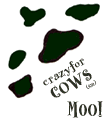|
|
|
|
|
|
|
Domestication and Gestation:
- Modern domestic cattle are believed to belong to either the species
Bos taurus (Holstein, Jersey, Guernsey, Brown Swiss, for example), or the species
Bos indicus which are humped cattle like the Brahman. Some cattle are a cross between
these two species.
- A breed is a group of animals that have been selectively bred for a long time, and
that have a distinctive color, size, conformation and/or function, and that pass these
characteristics on to their offspring.
- When cattle were first domesticated, the primary goal was to obtain meat and
skin, and to produce work animals.
- Initially, cattle produced little milk, just enough for their calves.
- The development of a high milk yield in cows is a result of breeding especially for
milk production, which occurred much later.
- The mean gestation period for Holsteins is 279 days.
- The mean gestation period for Brown Swiss is 290 days.
- Other breeds have gestation times between these extremes.
- Bull calves are typically carried about one day longer than heifers (female calves).
- Twins are typically born 5 or 6 days sooner than singlets.
- If a calf is a hybrid (from parents of two different breeds or species), it is carried for
a period of time between the gestation period of the two different breeds or species, usually closer
to the mother's.
Source: Encyclopedia Brittanica online http://www.brittanica.com,
entries Cattle, Domestication, and Gestation.
|
|



